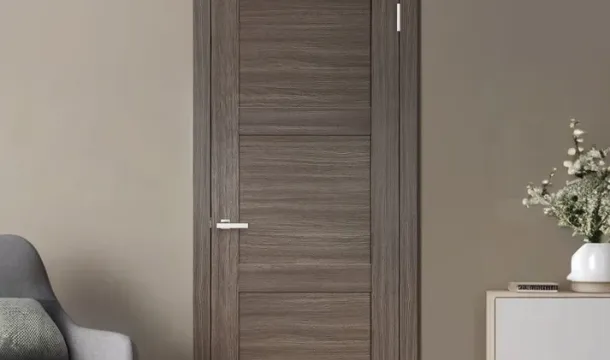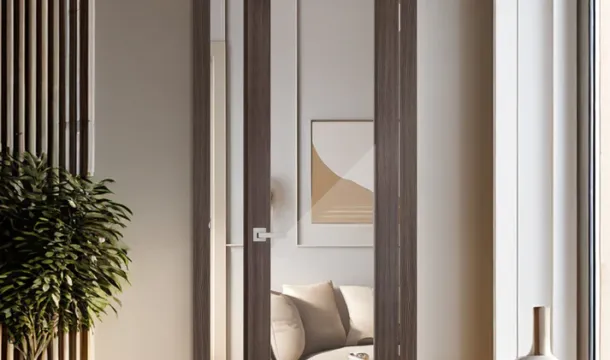Interior Doors for Small Spaces: How to Maximize Space in Your Home
Popular Articles
Living in a small space can be both a challenge and an opportunity to get creative with design and organization. Interior doors often take up more space than we realize, but with the right choice, they can help you make the most of limited square footage. Whether you’re dealing with a small apartment, a cozy cottage, or an individual room, choosing the right interior door can greatly improve the functionality and aesthetic of your space. This guide will explore the best types of interior doors for small spaces, tips for installation, and how to maximize every inch.
1. Understanding the Challenges of Small Spaces
When designing for a small space, every square foot counts, and even small details like door swings can have a big impact. Traditional hinged doors need clearance to open, which can become a major inconvenience if space is tight.
Common Challenges:
-
Limited Floor Space: Swinging doors require enough space for the door to open fully, often restricting how you can arrange furniture.
-
Blocked Pathways: When an interior door opens into a room, it can block pathways or reduce the usable space, making a room feel even smaller.
-
Closet and Storage Access: In small bedrooms or utility areas, traditional doors may make access to closets and storage difficult.
To solve these challenges, it’s important to choose interior doors that maximize the available space without compromising style or functionality.
2. Best Types of Interior Doors for Small Spaces
There are several types of interior doors that can help you save space and improve the layout of your small rooms. Here are some of the best options:
1. Pocket Doors
Pocket doors slide into the wall, completely disappearing when open. This makes them an excellent choice for maximizing space since they don’t require any clearance to swing open or closed.
-
Space Savings: Pocket doors save significant floor space because they don’t need room to swing.
-
Stylish and Versatile: Available in a variety of styles, from glass to solid wood, pocket doors can suit different decor styles and add a touch of modernity.
-
Installation Considerations: Pocket doors require a wall cavity to slide into, so they are best installed during construction or major renovations.
2. Barn Doors
Barn doors have become increasingly popular, especially in small spaces. These doors slide along a track mounted above the door frame, saving valuable floor space.
-
Visual Interest: Barn doors create a striking visual focal point and come in many different finishes and materials, adding character to your room.
-
Easy Installation: Compared to pocket doors, barn doors are easier to install since they don’t require wall modifications.
-
Limitations: While barn doors are great for saving space, they don’t provide the same level of privacy or sound insulation as traditional doors, which is something to consider for bedrooms or bathrooms.
3. Sliding Glass Doors
Sliding glass doors are a fantastic option for small spaces where you want to maintain an open feel. They can work well for dividing a living area from a bedroom or a home office.
-
Light and Spaciousness: Glass doors allow light to pass through, which can make a small room feel larger and more open.
-
Modern Look: Sliding glass doors add a modern, airy aesthetic to your space, perfect for contemporary interiors.
-
Privacy Concerns: If privacy is a concern, frosted or textured glass can be used to maintain separation without sacrificing light.
4. Bifold Doors
Bifold doors are made of two panels that fold in on themselves when opened. They are commonly used for closets but can also work for small rooms where a traditional door would take up too much space.
-
Compact Design: Bifold doors fold to one side, requiring much less clearance compared to a regular swinging door.
-
Versatility: Bifold doors are available in different materials, from wood to glass, and can be used for closets, laundry rooms, or as room dividers.
-
Maintenance: The track mechanism can sometimes be prone to wear, so proper maintenance is needed to ensure smooth operation.
5. Accordion Doors
Accordion doors are another space-saving solution, featuring panels that fold in a concertina style. They are particularly useful in tight spaces where a standard door isn’t practical.
-
Maximum Space Efficiency: Accordion doors take up minimal space when open, making them ideal for closets, utility areas, and narrow doorways.
-
Budget-Friendly: They are often more affordable compared to other sliding door options, making them a good choice for budget-conscious homeowners.
-
Aesthetic Limitations: While functional, accordion doors may not offer the same aesthetic appeal as pocket or barn doors and are best used in utility areas or rooms where appearance is less critical.
3. Tips for Maximizing Space with Interior Doors
Selecting the right door is only part of the equation. Here are additional tips to maximize space in your home while making the most of your interior doors.
1. Choose the Right Hardware
Using space-efficient hardware can make a difference in how well your doors function in a small space.
-
Flush Handles: For sliding and pocket doors, choose flush or recessed handles to avoid protrusions that could obstruct movement or take up unnecessary space.
-
Soft-Close Mechanisms: Installing soft-close hardware ensures that sliding doors close gently, reducing noise and preventing damage to the walls or door frames.
2. Use Light Colors and Mirrors
Light colors and reflective surfaces can make small spaces appear larger.
-
Light-Colored Doors: Opt for light-colored doors or doors with glass panels to create a sense of openness.
-
Mirrored Doors: Using mirrored sliding doors for closets or room dividers can make a small room appear much bigger by reflecting light and creating an illusion of more space.
3. Combine Doors with Functional Storage
Interior doors can also be multifunctional, serving as both entryways and storage solutions.
-
Hooks and Racks: Attach hooks or racks to the back of doors for hanging clothes, towels, or other items. This is particularly useful for bathroom and bedroom doors.
-
Built-In Shelving: For barn doors, consider adding built-in shelves on the wall behind the door when it’s open to optimize otherwise unused space.
4. DIY Installation Tips for Small Space Doors
If you plan to install space-saving doors yourself, here are some helpful tips to ensure a smooth process.
1. Measure Twice, Cut Once
Accurate measurements are crucial when installing doors in small spaces. Make sure to measure the doorway, the surrounding wall area, and any potential obstructions before purchasing or installing a door.
2. Choose the Right Tools
Ensure you have all the necessary tools before starting the installation, including a level, measuring tape, screws, a drill, and any specific hardware required for your door type.
3. Follow Manufacturer Instructions
Space-saving doors like pocket and barn doors often come with detailed installation instructions. Following these instructions carefully is key to ensuring the door functions smoothly and fits properly in the space.
5. Pros and Cons of Different Space-Saving Doors
To help you decide which type of door is best for your small space, here is a comparison of the pros and cons of each option.
Pocket Doors
-
Pros: Saves floor space, completely hidden when open, stylish.
-
Cons: Requires wall cavity, more complex installation.
Barn Doors
-
Pros: Easy to install, visually appealing, great for adding character.
-
Cons: Limited privacy, wall space required for sliding.
Sliding Glass Doors
-
Pros: Allows light through, modern look, space-saving.
-
Cons: Limited privacy unless frosted, may require custom sizing.
Bifold Doors
-
Pros: Compact, versatile, easy to install.
-
Cons: Can be noisy, requires track maintenance.
Accordion Doors
-
Pros: Budget-friendly, very compact, ideal for utility areas.
-
Cons: Limited aesthetic appeal, less durable than other options.
Maximizing space in small homes can be challenging, but the right interior doors can significantly improve both the functionality and aesthetics of your space. Pocket doors, barn doors, sliding glass doors, bifold doors, and accordion doors all offer unique benefits that can help you make the most of limited space while adding style to your home.
When selecting doors for small spaces, consider your specific needs, such as privacy, ease of installation, and overall design aesthetic. By choosing the right door type and incorporating additional space-saving tips, you can create a more open, functional, and beautiful living environment even in the smallest of spaces.
Popular Articles

Soundproofing Interior Doors: Which Options Are Best for Your Home?

Choosing the Perfect Interior Doors for Your Canadian Home
